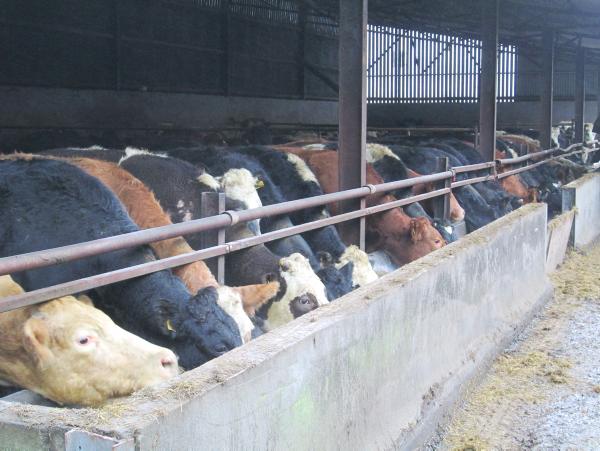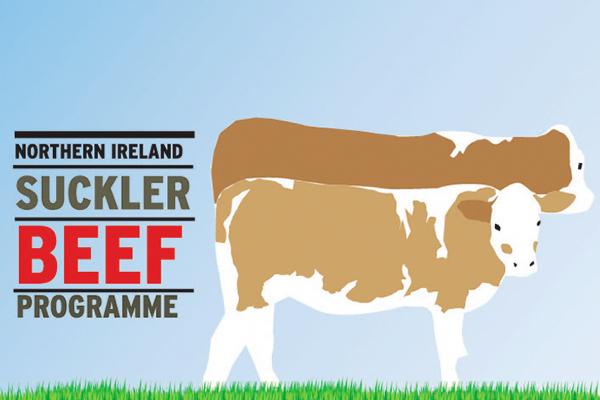Alan Cairns, Aghalee
I dosed the later housed cows and calves last week for fluke using Bimectin Plus which covers lung worms, adult fluke and sucking lice. Like many subcutaneous injections, this does not give a full kill of biting lice so Flypor was also used to cover both biting and sucking lice.
Despite some restriction of silage to dry cows, they have maintained body condition score (BCS) since housing and currently range from 3.0 to 3.5.
In hindsight, I probably could have restricted cows even more up until now. Calving is starting in six weeks’ time, so further restricting of silage to the earliest calving cows is not an option, but some of the later calving cows in BCS above 3.5 are being cut back to 28kg per head per day.
All cows are being fed a pre-calving mineral at a rate of 100g per day from eight weeks prior to calving.
Last year’s spring-born calves are almost 40kg heavier than previous years as a result of good summer grazing and less calves being born in June and July. They are currently eating 2kg of a 16% crude protein blend per day along with first cut round bale silage.
Calves are growing and like the cows have held their condition since housing. I intend turning these calves out to grass by early March if conditions allow. To prevent calves being over-fleshed at turnout, I will reduce the meal fed from the end of January.
I have found bales from different fields, despite being cut on the same date and ensiled at the same time, to vary in silage quality. The first bales sampled back in October gave analysis as low as 10.3 ME and 8.0% crude protein with a D-value of 65.
More recently sampled bales are 70 D-value with 11.4 ME and 11.7% crude protein. From this year onwards, I will try to mark bales from different fields to ensure cattle are getting a consistent silage quality.
Using a Simmental bull over the last two years has now left me with some ideal herd replacements for bulling this summer. I hope to reap some of the benefits of breeding my own replacements such as reducing the disease risk in the herd.
Purchasing replacement heifers and cows did allow me to cross more cows to a terminal bull, but, year on year, I was never really improving the herd. I now have two Simmental stock bulls and replacement heifers on the ground which I feel will improve rather than just maintain herd performance going forward.
Last week, I sold a batch of 10 steers in the mart which were born in late summer 2012.
These cattle did not get off to a great start with weather conditions in that year. They averaged 440kg with an average price of £978, or £2.22 per kg liveweight.
While I would be content with the price, there is really no margin for me in these calves born in late summer and carried over as steers.
Finishing cattle are now on 7kg of meal and ad-lib second cut silage and should be ready for slaughter over the next few weeks. Ideally, I would have finished all of these cattle but with cows not long off calving I need the housing space for the earlier calving cows.
I completed the annual farm benchmarking this week. The overall report after number-crunching will be back in a few days. Going through basic input information such as cattle births, sales and costs alone showed up some trends.
While I was fortunate that I had enough silage to get me through last year, I lost far too many cattle last spring through weather-related issues.
I am currently setting up more calving pens and a communal straw bedded area for cows and newly born calves if turnout is not possible.
Cows are also being brought home from an outfarm so that calving is not taking place in two different yards. Having cows scanned, I also have a much better idea of individual cows’ calving dates.
Last week, I carried out soil analysis, mainly on fields not sampled over the past three years but also on some fields which in the past showed low pH, phosphorous and potash levels to see if changes in slurry, lime and fertilizer applications has been effective.
Walking the fields at this time of year is also a good opportunity to check for leatherjackets. Excellent grazing conditions last summer and autumn have certainly led to a marked improvement in swards which this time last year would have been considered for reseeding.
Alan Cairns, Aghalee
I dosed the later housed cows and calves last week for fluke using Bimectin Plus which covers lung worms, adult fluke and sucking lice. Like many subcutaneous injections, this does not give a full kill of biting lice so Flypor was also used to cover both biting and sucking lice.
Despite some restriction of silage to dry cows, they have maintained body condition score (BCS) since housing and currently range from 3.0 to 3.5.
In hindsight, I probably could have restricted cows even more up until now. Calving is starting in six weeks’ time, so further restricting of silage to the earliest calving cows is not an option, but some of the later calving cows in BCS above 3.5 are being cut back to 28kg per head per day.
All cows are being fed a pre-calving mineral at a rate of 100g per day from eight weeks prior to calving.
Last year’s spring-born calves are almost 40kg heavier than previous years as a result of good summer grazing and less calves being born in June and July. They are currently eating 2kg of a 16% crude protein blend per day along with first cut round bale silage.
Calves are growing and like the cows have held their condition since housing. I intend turning these calves out to grass by early March if conditions allow. To prevent calves being over-fleshed at turnout, I will reduce the meal fed from the end of January.
I have found bales from different fields, despite being cut on the same date and ensiled at the same time, to vary in silage quality. The first bales sampled back in October gave analysis as low as 10.3 ME and 8.0% crude protein with a D-value of 65.
More recently sampled bales are 70 D-value with 11.4 ME and 11.7% crude protein. From this year onwards, I will try to mark bales from different fields to ensure cattle are getting a consistent silage quality.
Using a Simmental bull over the last two years has now left me with some ideal herd replacements for bulling this summer. I hope to reap some of the benefits of breeding my own replacements such as reducing the disease risk in the herd.
Purchasing replacement heifers and cows did allow me to cross more cows to a terminal bull, but, year on year, I was never really improving the herd. I now have two Simmental stock bulls and replacement heifers on the ground which I feel will improve rather than just maintain herd performance going forward.
Last week, I sold a batch of 10 steers in the mart which were born in late summer 2012.
These cattle did not get off to a great start with weather conditions in that year. They averaged 440kg with an average price of £978, or £2.22 per kg liveweight.
While I would be content with the price, there is really no margin for me in these calves born in late summer and carried over as steers.
Finishing cattle are now on 7kg of meal and ad-lib second cut silage and should be ready for slaughter over the next few weeks. Ideally, I would have finished all of these cattle but with cows not long off calving I need the housing space for the earlier calving cows.
I completed the annual farm benchmarking this week. The overall report after number-crunching will be back in a few days. Going through basic input information such as cattle births, sales and costs alone showed up some trends.
While I was fortunate that I had enough silage to get me through last year, I lost far too many cattle last spring through weather-related issues.
I am currently setting up more calving pens and a communal straw bedded area for cows and newly born calves if turnout is not possible.
Cows are also being brought home from an outfarm so that calving is not taking place in two different yards. Having cows scanned, I also have a much better idea of individual cows’ calving dates.
Last week, I carried out soil analysis, mainly on fields not sampled over the past three years but also on some fields which in the past showed low pH, phosphorous and potash levels to see if changes in slurry, lime and fertilizer applications has been effective.
Walking the fields at this time of year is also a good opportunity to check for leatherjackets. Excellent grazing conditions last summer and autumn have certainly led to a marked improvement in swards which this time last year would have been considered for reseeding.






 This is a subscriber-only article
This is a subscriber-only article











SHARING OPTIONS: